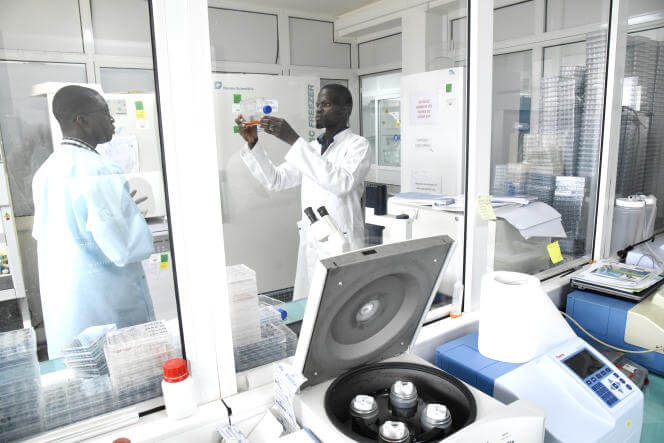Share
Although efficient and quite reliable, one COVID-19 antigen testing kit currently costs $30-50 in the United States. Facing the challenge of mitigating the virus spread under financial constraints, African researchers have worked on developing protocols for testing as many people as possible, in a cost-efficient and rapid manner.
Over the last few months, several African innovations against coronavirus have proliferated, from touch-free handwashing tools or generating lung X-ray scans from sounds in Kenya, home-made ventilators prototyped in Somalia, using drones to drop off testing kits in hard-to-reach places in Ghana, or deploying robots in treatment centers in Rwanda. In this article, we focus on two innovations: a new method for pooled testing in Kenya, and a £1-diagnostic kit in Senegal.
While waiting for the development and production of an effective vaccine, countries around the world must monitor the virus spread by carrying out testing campaigns. However, regular testing of every individual is expensive. Cost reductions can be achieved by pooling (or combining) samples from multiple individuals and testing them in group. Pooled testing is challenging because it requires to find the right balance between maximising the group size while maintaining test sensitivity (the bigger the group size, the more the sample dilution, the more likely the false negatives), and the right balance between minimising the number of tests to perform and reducing the virus spread.
The idea of pooled testing was first proposed byRobert Dorfman in 1943. A few weeks ago, a joint work between the University of Rwanda, the Rwanda joint COVID-19 taskforce, and the African Institute of Mathematical Sciences (AIMS) proposed a novel, more effective pooled testing strategy to quickly identify SARS-CoV-2 (COVID-19). The strategy relies on pool-testing groups of 100 people in low infection prevalence areas. Early evidence shows that the method enables results to be reported in less than 24 hours and is less costly. For instance, in an area with a prevalence rate of 0.05%, while Dorfman's method allows for a 22-fold testing cost-reduction, this new strategy offers a 100-fold cost reduction.
The science behind the strategy has been published in the prestigious science journal Nature, and involves researchers from multiple countries across the continent. Among them are Professor of human genetics Leon Mutesa (Rwanda), theoretical Biologist Wilfried Ndifon (Cameroon), and Physicist Neil Turok (South Africa).

Institut Pasteur de Dakar. Taken from here
How does the strategy actually work? Instead of directly testing the samples taken from every individual, the researchers divide each of them into equal subsamples. From there, they use geometrical concepts and determine the minimal number of subsample pooling combinations they need to test (slice tests) in order to uniquely identify positive subsamples (if any). They theoretically show that their strategy can detect one infected person in a population of 1 million with only 39 tests (instead of 1 million tests!). More importantly, they proved the viability of the method through practical experiments in several Rwandan health facilities for up to 100-individual groups. Further field trials are underway in Rwanda and South Africa. The full method is explained in this short video, and more thoroughly in the original publication.
This recent breakthrough opens many opportunities as Rwanda has already adopted group testing as a national strategy. The method is currently used by a South African rugby team of 81 players and staff which must be tested regularly. Care homes and pre-commercial flight group tests are other potential areas of applications.
In parallel, an effort to reduce the costs of the antigen and antibody #2 testing kits has been carried out at the prestigious biomedical research center Institut Pasteur de Dakar (IPD) in Senegal. Indeed, researchers from the institute have been working to produce a low-cost, rapid, at-home test kit. The kit works as a pregnancy test, where patients apply a drop of blood on a color-reactive stripe. They hope to lower the costs to £1 per kit.
This project is a collaboration with the British biotechnology company Mologic and the IRD (French National Research Institute for Sustainable Development). While the prototype is mainly developed in the United Kingdom, the Institut Pasteur de Dakar is taking part in the prototype evaluation and production efforts. Indeed, the end goal is to productionize and distribute the kits locally, and the IPD runs DiaTropix, an infectious disease testing facility suitable for manufacturing the diagnostic kits.
Since the announcement of the collaboration early 2020, a professional-use version of the rapid diagnostic test has been certified for manufacture and global distribution. The ongoing efforts aim to refine the test stripe and optimise the manufacturing process in order to meet the £1 price target.
With its expertise in epidemiology, the IPD has also trained laboratory staff from 15 African countries in how to test for the virus earlier this year. This expertise was acquired when dealing with other diseases in the past (dengue, Zika, Ebola, malaria, etc.). As a matter of fact, during the 2014 Ebola crisis in West Africa, it had already developed a kit to make a diagnosis in 15 minutes. Since 2017, it has started using an autonomous mobile laboratory. This laboratory is embedded in a truck, which makes it suitable to reach hard-to-access places. In particular, it enabled the institute to carry out missions in several regions in Senegal, from the mountains of Kédougou (South East) to the wetlands of Sine Saloum (West).
Such breakthroughs highlight that African researchers are at the forefront of the efforts to eradicate the virus spread. Both initiatives presented in this article will enhance rapid, efficient and low-cost testing systems, which experts everywhere in the world are and should be learning from.
Would you like to submit an article to us? Contact us at editors@theafricaiknow.org
Our Newsletter
Subscribe to our newsletter to keep up with our programs and activities, learn about exciting developments in Africa, and discover insightful stories from our continent's history.